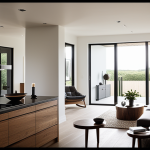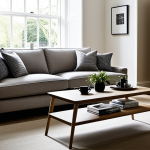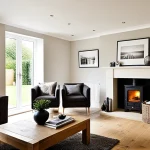Immediate ways to introduce minimalist design into British home style
Adopting minimalist home design in British interiors begins with embracing key principles that harmonise with traditional elements. Start by decluttering—removing excess items creates space to appreciate architectural details typical in British homes. This straightforward step is both fast and low-cost, instantly refreshing any room.
Next, opt for a neutral palette: soft creams, greys, and muted beige tones align well with British décor tips. These colours enhance natural light, essential for often dim UK interiors, balancing modern minimalism with classic warmth. Updating lighting fixtures to simple, streamlined designs also brings brightness and a contemporary feel without overwhelming period aesthetics.
Have you seen this : What are the top tips for selecting UK home furniture?
To visualize these changes, consider UK homes where minimalism meets tradition. For example, before-and-after scenarios show how removing bulky furniture and introducing light-toned curtains transforms cluttered rooms into airy, calming spaces. These adaptations maintain British charm while adopting a fresh, minimalist British interior style.
By focusing on decluttering, subtle colour updates, and improved lighting, homeowners achieve an accessible, immediate start to minimalist British décor—proving that impactful change needs not be costly or complex.
Have you seen this : How Can Small Changes Transform Your Home’s Comfort and Style?
Balancing British character and minimalism
Blending minimalist adaptation with the rich heritage of British period homes requires careful consideration to preserve British heritage while embracing simplicity. Start by identifying key architectural features—like ornate cornices, sash windows, or exposed beams—that define the home’s character. Instead of removing these, highlight them through minimalist design by keeping surrounding decor simple and unobtrusive.
Deciding which classic elements to emphasise means streamlining rather than stripping away. For example, a Victorian fireplace can become a focal point when paired with pared-back furnishings and clean lines. Light, airy walls and floors enhance space around traditional features, allowing them to stand out without clutter.
A strong example comes from Victorian homes transformed with minimalist interiors: stripped-back furnishings complement original woodwork, combining elegance with restraint. This approach honours craftsmanship while adopting the minimalist British interiors ethos.
Balancing character and minimalism also means thoughtful curation—choosing a few heritage pieces and integrating them with modern simplicity. This selective focus maintains warmth and historical context, proving that minimalist design can respect and enrich British heritage rather than erase it.
Immediate ways to introduce minimalist design into British home style
Introducing minimalist home design in British interiors can begin with three straightforward, effective steps. First, decluttering is crucial. By removing unnecessary items, you instantly create a more open, calming space. This not only highlights existing features typical of British homes but also simplifies daily upkeep. Decluttering is a low-cost, fast change that yields significant visual impact.
Second, adopt a neutral palette suited to British decor tips—think soft creams, muted greys, and warm beige tones. These colours enhance natural light, which is valuable in often dim UK homes, and create a soothing backdrop that aligns with minimalist British interiors. Using such palettes is vital to maintaining warmth while embracing simplicity.
Third, update lighting—replace bulky fixtures with sleek, simple designs that boost brightness without cluttering the room. Modern lighting brings a fresh yet unobtrusive feel that complements traditional British settings.
Real-life examples from UK homes show how stripping away heavy furniture and introducing pale curtains or blinds refreshes spaces. These steps quickly transform rooms, demonstrating that minimalist British interiors can be achieved with minimal effort, cost, and disruption.
Choosing minimalist colour schemes suited to British homes
Colour plays a vital role in minimalist British interiors, particularly given the UK’s often overcast light. Embracing minimalist colour palettes built around soft neutrals—like pale greys, warm creams, and gentle taupes—creates the perfect backdrop. These tones enhance natural light, making rooms appear larger and calmer, essential for achieving calming interiors.
But how can you add interest without undermining minimalism? The key is subtle accent colours. Introducing muted blues, sage greens, or dusty pinks in cushions, throws, or small decor pieces complements traditional British colour trends while maintaining simplicity. Avoid bold, intense hues that disrupt the peaceful atmosphere minimalist design demands.
Creating warmth and depth is crucial in British homes, often challenged by limited daylight. Layering texture within the palette—through matte paints, soft fabrics, or natural wood tones—adds dimension without clutter. This nuanced approach respects minimalist principles yet retains cosy, inviting energy.
In summary, choosing the right minimalist colour palettes tailored to British homes means balancing neutrality with subtle accents. This enables homeowners to enjoy the elegance of minimalism alongside the familiar warmth British colour trends typically provide.
Balancing British character and minimalism
Striking the right balance between preserving British heritage and adopting a minimalist adaptation can be challenging but rewarding. To achieve a period home minimalist style, start by identifying architectural features that define the home—ornate fireplaces, sash windows, or decorative cornices. Rather than removing these, minimalist interiors highlight them by simplifying surroundings, allowing traditional details to become focal points.
When blending Victorian or Edwardian elements with minimalism, consider which classic features to emphasise and which to streamline. For example, maintaining an original wooden floor while replacing bulky furniture with sleek, uncluttered designs shows respect for heritage without crowding the space. Minimalism here supports the home’s story rather than overwhelming it.
A successful minimalist adaptation in period homes involves layering textures and materials subtly, preserving warmth alongside simplicity. This prevents a sterile look that commonly arises from over-simplification. By integrating heritage features into a minimalist framework, homeowners enjoy clean lines and understated elegance that keep British character intact yet refreshed.
Such transformations demonstrate that minimalist British interiors need not erase history but can enhance it through careful, thoughtful design choices.
Immediate ways to introduce minimalist design into British home style
Integrating minimalist home design with traditional British elements begins by focusing on simplicity that complements, not conflicts, with heritage features. Essential changes are both fast and affordable, ideal for immediate impact. Start with decluttering: removing unnecessary objects frees space and reveals architectural details often hidden in British homes, such as mouldings or bay windows.
Adopting a neutral palette is another key step. Soft whites, greys, and subtle beiges not only brighten interiors but also create the calming backdrop minimalism requires while harmonising with classic British colour schemes. These tones reflect natural light, helping rooms feel more open and welcoming.
Lighting updates further enhance simplicity and space. Swapping dated fixtures for sleek, understated designs balances traditional British style with a fresh, minimalist look. Modern lighting adds brightness without dominating a room.
Visual examples from UK homeowners reveal how these three steps—decluttering, neutral colours, and lighting—transform cluttered, dark rooms into open, serene spaces that remain true to minimalist British interiors. This approach proves that embracing minimalism is accessible and respectful of British decor tips, making homes feel modern yet familiar.
Immediate ways to introduce minimalist design into British home style
Introducing minimalist home design in British interiors effectively means balancing simplicity with tradition. The key is to integrate British decor tips that respect historic details while streamlining spaces. Immediate changes focus on three practical steps: decluttering, adopting a neutral palette, and refreshing lighting.
Decluttering removes excess items that hide architectural features characteristic of British homes, such as cornices or bay windows. This fast, low-cost change instantly opens up rooms and reduces visual noise, highlighting the structure rather than competing with it.
Next, choosing neutral colours like soft greys, creams, and beiges aligns perfectly with minimalist British interiors. These palettes amplify natural light in often dim British homes, creating a calming, airy atmosphere that complements traditional accents without overshadowing them.
Finally, updating lighting to sleek, unobtrusive fixtures brightens spaces while maintaining a minimalist feel. Modern lighting designs can subtly enhance features without cluttering the décor.
Real-world examples from UK homes show how these steps transform cluttered, dark rooms into open, serene spaces that honor a minimalist ethos while staying true to British style. These changes provide accessible, immediate methods for anyone seeking a harmonious blend of minimalism and heritage.











